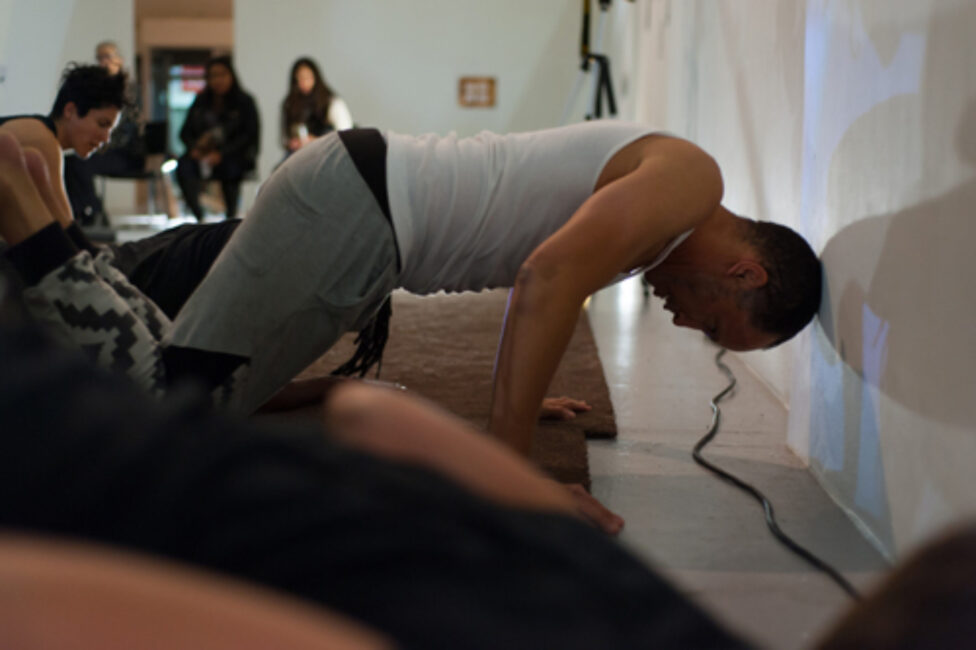My question is: Were there any lingering thoughts from our conversation that we started two weeks ago?
I felt like Sebastian’s reasoning was really, really solid. The idea of continuing to create this container for purposes of process—what comes out of that is dictated by the people who inhabit it or that local community, those who bring their ideas and experiences.
I think about the idea of the rhizome, an underground structure that spreads laterally…
On the other hand I could imagine something going on from where we sit kind of feeling like I can’t reach it. It’s kind of far away. I find myself really curious about this idea of being able to have an experience and then take that experience and drop it somewhere else and stand back and watch and see how that grows or what comes out of it
That’s what I struggle with. A framework that can be lifted and placed in any island, in any realm. What about the responsibility to the process that has already started..?
The process that includes the rest of the folks that are already involved?
The process that involves all of us, that we started a year ago, and, even to the extent of breaking the conceptual framework—this was going to be a year only. That year will be up in March but how can it stop? Some connection to process that happens across bodies, like actual living real people.
It’s not just a conceptual framework.
And also because its one thing to set up a framework and its another thing to actually put it in motion. It’s actually the putting it in motion that makes it feel like, well actually…
Hi Hi, glad you could make it. We’re taking a pause, Kristianne just walked in.
[Chatter, compliments, greetings]
OK, continuing… What it means to continue the project, to continue the school, and what continues. What it means to set this structure, to see this as a structure, to see this as a template, to airlift it and place it in another population. Which reminds me of the parachute thing that Joy brought up. This idea of…what was it?
Like a parachute artist.
I just start writhing, just the notion of that. This art thing that functions like a community service provider in a thinly-veiled way… It really frightens me to think that anyone would see the work in that manner. Not that I believe that that’s the only way such an approach would be received but I think it’s there in the air, potentially. So there’s that thought versus this kind of commitment, fidelity to our group, and continuity of our process. Which feels like it’s still processing, right? And where does that go? And, which… I’m going to stop talking. Which is interesting in relation to social sculpture. A frame is set that creates a type of social architecture, and then that thing moves, continues to live on, ideally outside of the thing that set it up.
I wonder if, I don’t know, kind of like in our current, kind of cultural, whatever it is, conundrum. It’s… how do I say it? It seems like the modern movement, it was a way of divorcing ourselves from tradition. So, that’s left ritual out of a lot of what goes on as our practice. It seems.
By modern movement you mean Modernism?
Yeah, Modernism, which kind of coincides with the growth of industrialism, and capitalism, and communism, and its colonialism. It’s all of that. As a contemporary modern person, I sometimes wonder, does that mean that I’m just at this moment and in the know… contemporary guy? Or does it mean I’ve accepted a colonialist kind of agenda? Or something like that. So, I don’t know. To make a long story short I wonder if in some ways to create a social sculpture, something that actually does create a process that stays alive, either in the community or in the bodies of the people that come into the project. If it’s because that really affects some kind of social change or it’s an experience that people take with them. I’m not always confident that I can do anything I want on-stage or raise any issue I want. The audience, they only take away from it what they choose to or what they’re prepared to. But some kind of experiment in community, that is an art-making at the same time, it’s kind of a different beast.
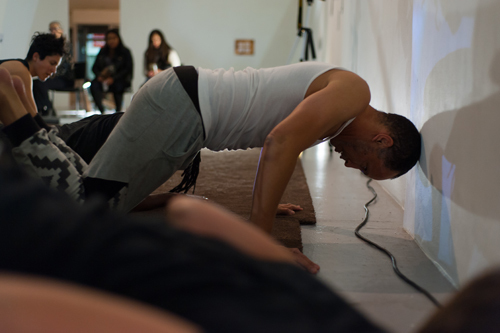
this is the caption for this image
What came up for me… ok, first I’m going to start with my questions. How can I support what’s happening next? Like you were saying… I’m going to start with this image—talking about the parachute. I was thinking about the way epidemic spread works… One person who is affected goes to a different place and when that person leaves, it continues to grow. Then there’s another start there, and this might be even the people who were exposed by that first person or possibly a different, unknown start altogether. Without it being such a dark image, this feels like how this process and structure has felt. Because from the very first day, I couldn’t see how I’d be a part of it. I didn’t see, as I can right now, how much it’s changed me in a really subtle way, also in a very prominent way. I know that that came from that experience. And then being aware of those two possibilities—like I have the choice to either keep going with it and still be riding that process or sit with it for a little bit and let it stagnate. Or the other way around, take it with me and move onto something different. I think what was wonderful about this structure is that it was inter-layered. So, yeah what you were talking about, audience, as the artist who is putting in the work on-stage, you can put whatever you want in there but the audience gets to choose what they take in, how they take it in, and how it affects them, right? But what’s so beautiful about dance and this structure itself was the beginning, this inclusiveness of where people were… Letting the progression of the structure evolve with the people who are in it, and who’s not in it, and who’s added later and, you know, all of the complexities that we added to the group because we are all individuals who are living very real lives that are very opposite and different. And so to the level of the performance, coming from whatever they, the audience, sees and then accepting what they cannot see. Which is the process within us as a group and within us as individuals. Because the process for me never ended after the rehearsal ended. It was also in the drive home—three hours of driving back and three hours of driving towards—that was part of my process… sitting with the things I heard and experienced just echoing in my head. And it’d produce this energy, energy, energy, and that brought me back to rehearsal the next Saturday. The multiplicity of these layers of this structure…
I’m really struck by what you said about meeting people where they’re at, and that becoming what drives the process rather than this kind of concept that people’s lives have to serve. It more comes from the people that are involved. Or at least that’s a significant layer.
I remember from some rehearsals we had, you, taisha, sent us some videos or some articles and stuff, and here I am thinking I’m going into rehearsal and we’re going to be talking about this. And then the conversation completely goes somewhere else. There’s no attachment to whatever’s brought up. But whatever’s brought up is what brought us to where we’re at that moment, so it’s not wasted. I felt like that was very tangible for me, and it made sense to me right away. After the first three rehearsals it made sense. I’m like, okay, this is how we’re working. Yeah.
I think it is productive for me to not be fixated on the thing. Like, we’re all going to bring backpacks to a rehearsal, so we can all do a “backpack dance,” and that’s for what that backpack-ness brings into a room. I’m not interested in the backpack but maybe what posture comes from the backpack or the conversation that comes up—where people got their backpacks and in relation to where. I don’t know. Get away from “about-ness” and move more toward creating, thinking of ideas more like fascia, you know?
They’re interconnected.
Yeah, that ideas form architectures, or that ideas are sculptural. They’re not things you can point at singularly. It’s the whole.
In some ways it feels like the impossibility of the whole task. Like the whole endeavor to set out, even to do, to make a piece or a project with so many people in a limited time. And the subject matter being so important and so big and so vast. And people coming from so many different backgrounds. The impossibility stacked upon other impossibilities I think in some ways made that atmosphere…there’s so much there that it really lent itself to this undercurrent of energy and ideas that were sometimes spoken out loud but sometimes not spoken. I’m reminded of something that Turay mentioned the last time we met, not just about the art-making but about how we relate to each other as a company. Even in decision-making process, whatever that means… To communicate by speaking but also what’s communicated by not speaking. I think that would be another desired element in the bundle. Somehow fostering those two kinds of communication, or many different kinds of communication, through touch, through dance, through making, through speaking, through sharing. Then we find ourselves in positions where right now, or the last time we met, we’re trying to function as a collective or a governing body and trying to make sense out of these ideas and trying to make a decision about how to move forward. It’s interesting to me that we participate by talking out loud but also by not knowing how to and silently agreeing or disagreeing. Just being in the soup of things. It’s not going to be a consensus but it does lend itself to a richness and a kind of communication that feels really solid no matter what, with all of the things that we’ve talked about. There was really the possibility of not only wildly different opinions or feelings about different things, but it feels like the communication between everybody was… full of respect is not really what I mean… in real consideration of each other. That is a different way of communicating than a regular school or an academic setting. I think those hierarchies were successfully challenged. The thing that you say about ritual, Heyward, is interesting to me because that seems like a satisfying way to transmit information instead of a capitalist art-making/branding thing. We did this thing and now you do this thing and it’s the other iteration of it. Something about passing information along in the way that we did—people who came into the workshops or the idea of learning a tradition or learning a ritual, or creating your own ritual seems better or more in-tune with what I think we’re going for. I also wonder what would happen with the experiment if we, I don’t know how plausible this is, or even if anyone wants to do this, but the idea that everything continues, like the virus. It starts in another place and we continue our practice, and everyone eventually interacts. The idea of that spreading is amazing. I don’t know if that could happen, but…
Today I was coming from a rehearsal. I wanted to choreograph for an alumni and I brought up the experience of being a part of WXPT and then talked to them through my own lens of how the process unfolded for me. The thing is everyone had different entry points of how they came into this project. I appreciate the unknown of why I’m here. I didn’t know what the decision-making was and I didn’t know that I was going to be part of it. I was an hour late! [laughter] I told you, I was like, “Can I just watch? And you’re like, “No, you’re dancing.”
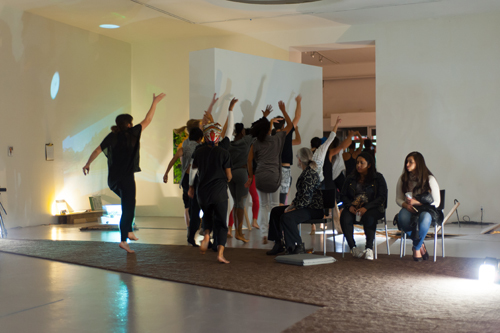
Yeah, you were thrown into it.
Even the first performance, I was thrown into it too. A lot of my experience was: How do I fit? Okay, I’m a part of it somehow, and I’m trusting that I’m a part of it, but how? And then also understanding how it was all similar to my own experiences. Can I relate to taisha’s experiences and what she’s talking about and to Turay’s experiences of what they’re talking about? There’s just all of that. I got into so much of the politics… I have never been so much into that. I’m this immigrant who came into the U.S., and actually the main thing that I had was knowing that I needed to learn English. I knew people were judging me because I didn’t speak the language, so that was the main priority. I didn’t understand it quite yet that, oh, I’m seen as a second-class citizen because of my identity. None of that, until being in this process, and it was a long time, over ten years, of living here. Being bombarded by real-life experiences and talking about it, for me, started this curiosity. I feel like a lot of younger people take that as reality. We just accept it. But there was a kind of resistance in the existence of this structure… And, having these conversations. So I feel like, yes, we keep going, and I’m keeping it going, that work that I’m working on.
I feel like something similar happened with me that makes me really interested in what will happen in a different place, in a different city, in particular. In my mind and heart I’ve been politically conscious and engaged in similar conversations. But I feel like the pairing of getting to know this particular group here and also being new to Los Angeles, the conjunction of those two things have made me think about race and gender just in a very different, heightened way. In a way that I feel like I maybe took for granted in New York, just being around a lot of people or feeling like some things were more okay than they were. This very tight-knit group came together just as I was settling into a city that is very isolating, and very segregated. I think about race more here, and I didn’t expect that at all. I really wonder about Texas, and I wonder what other places are like. It’s very different everywhere.
I’m reminded of really close friend who I’ve known for a long time. This one conversation… Recently I was telling her about WXPT and she had this response where she was kind of like, now that I think about it I think we should have just let the South go. And her reasoning was we fought this really, really bloody war, to keep this part of the nation that had this very questionable economic, based-in-slavery, as a part of the whole. And part of that conversation was, things are getting better there too, but her thought was that if we had just let the South go, maybe it would have been better for what wasn’t the South. And the South itself would have maybe made more progress. It would have been left to its own, whatever it was doing. That was also around the time that the Confederate Flag was taken down in South Carolina, the time that we were having this conversation. That was when we were doing our thing, too. I thought that that was a really interesting response.
My father’s from South Carolina, so I still have some aunts there. I remember when that debate was going on, finding out about why the flag was there in the first place. It was there because basically white law-makers put it there to protest the integration of the schools there. A part of me wanted to call my aunt, and go “why are you living in that place?” A part of me just couldn’t. Maybe part of that comes with growing up on the West Coast, or something. It’s not like the West Coast is heaven or anything like that when it comes to race relations. But, yeah, it’s needed. I have to say that all my information about the South is second-hand. I’ve never been. My father avoided it, until he was really old, going back to the South. My mom and her sisters weren’t allowed to spend time at friend’s houses because they grew up in neighborhoods that were mostly white. From my grandpa’s experience, you could have anything done to you and no one would be held accountable. It’s like… here we are again.
When you mention the word, stop policing yourself some time ago, this little trigger went off in me. Policing, who are the police? The whole thing gets into very dark stuff around our bodies and how bodies of color have been made to carry a certain thing. It’s really pretty hard to shed. It’s woven into the fabric of how people think and relate in this country. It’s locked in there. Sometimes it’s like a bulldog. It’s got its teeth in and it won’t let go. And then, here comes Donald Trump. It’s really wild stuff. I’m curious to be able to have the opportunity to witness or have some experience of how people in the South would actually…what their process would be like, or what would it bring out. Maybe different experiences. There have got to be a lot of correlations. The generation of people that migrated here from the South are either really, really old or they’re starting to not be with us anymore. It’s taken me a long time to get it that people migrated, and that there’s a body that’s supposed to be there. It has meaning. But, the rest of the way that I live modern life tends to abstract it. I’m not really satisfied with it being abstracted.
Wait, I lost it. What’s the “it” there?
Which “it”?
You said you’re not comfortable with it being abstracted.
That the meaning of bodies moving across geography impacted by an experience or an ecology that’s either social or cultural. That’s either supported or destructive. The unfortunate thing in our country’s case, a lot of it has been not so nice.
My question that’s following that is, then, as a community of people coming from different places what do you call that?
As a community coming from different places?
Existing together in the same… sharing same place, geographically.
Yeah, does that then, because of space, does it make them a group?
I don’t know. Because it starts to get into that “what is a nation?” kind of thing.
We all carry our own cultures and our own histories but then all of a sudden you’re in this configuration of different people. What is that, as a whole? What does that make all of us, together? I feel like this is one thing that I never understand. It’s so simple in this structure that we’ve created together. We all had these similarities and differences and our own identities, but that together was the art of dance. Making art together. And then somehow that made us a company. Does that make sense?
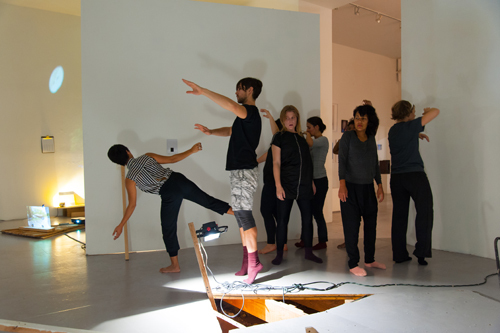
I feel like that’s the thing, thinking of a dance company as a type of population, as a type of community, as a type of collective body. What happens if you hold the framework of the dance company but change all of its rules and change how it operates, and what it does, what that group of people do when they’re together? Otherwise nothing, I would say, is our common denominator. All the way to the fact that you live all the way in a different county and Kloii’s over there and everyone’s backgrounds are different. No one is the same height and no one thinks the same thing about performance. It’s kind of like the company became this arbitrary kind of border.
Yeah, that’s a whole other tangent. From my own perspective a lot of this was in filling the limits. The question of what can art do and the limits of my own practice in relation to the things I wanted my practice to take up. And feeling like I can’t take them up with just my body. I can’t take them up just in doing solos for this or that audience. When we all came together I didn’t know what we were going to do. I just knew that it was important. That it’d be a catalyst for people to create meaning together in whatever form that might take, and to keep listening to what comes up. The fact is that I was so terrified to have some of the conversations that we had, early on. And also quite terrified by everyone’s sense of why they were there. Like, this person is expecting this, and this expecting that, and this person is expecting, and. Whoa. Who is going to be right? Who’s going to get the thing that they want? Maybe just for this time, surrender. I think that was what was helpful, actually, about holding it to a year. This is a container that can be held for a year but not much longer, to some extent. Which is what makes it feel so fraught now. Because it got set in motion, now what does it mean to break it? Or to let the timer go off and say, “done!”
I think also what’s come up is a broader question of authorship. It’s not my choice to say that it’s done, because it’s not really mine. The relations that have been built and the experiences and what people take on and utilize and trouble in their own work or their own relations, and that belongs to you, and you, and you. I know there’s this moment when my father got sick and I just couldn’t do anything, but felt like it was important to keep the process going. I thought maybe I’m going to be overthrown, and maybe that’s great! Maybe that’s what needs to happen. Even though I was afraid to have a lot of conversations, I did feel it was important that they happen, and that we kept returning to the body, to practice in some way. But now I have this impulse for us to now just be in the studio. It’s like we had to work all this up to actually be able to have like a real experience in the studio. It would actually be so satisfying.
It probably is obvious or sounds redundant, but it feels like the school or the approach or whatever we’re doing, we’re uniquely poised to address all of this stuff. All the trauma around bodies and bodies in migration and history of bodies. It does sound so obvious to me but most of these conversations are just conversations. Or they’re people online, writing feeds or arguing with each other or in schools or not talking at all. It’s so rare for people to even talk with people who are different from them, and to consciously get a group of people together and work through these things in a non-linear way, with the body. That’s the point of it. It feels like the inherent value. It’s very powerful. I would imagine that if it did take all this time to get to that understanding I would be really interested to see what comes up physically, after all of that.
Can I ask you something? Maybe a closing thing… Maybe you can modify this. What’s a single question that is still lingering for you concerning this process? Maybe a question that came up before that never got solved. A question that remains. Something that never got addressed. A question that needs to continue to be asked. Something that needs to be in the room of this conversation. Or just something that has been stirred up.
I have one thing that I’m still trying to find answer to as an artist and, in the process, everything we’re talking about feels relevant. How then can I put that in the body, and what gets put in the space in the work? What’s taken out and what’s that filter that we’re using? How is it going to be translated? Not even translated, but put in. Because translated makes it seem like it’s turning into something else, that the body is there the whole time. How is that, what’s the word? I don’t know what the word is to describe that, but it’s not translating. From this conversation, from all of this growth, from all of this insight to movement, to the physicality of the body, and all of that.
What are we manifesting? What gets manifested?
Yeah, what gets put? What is that filter? What’s that line or how does it get crossed? That’s has been the ultimate thing from the very beginning ’til the end. I’m still dealing with it.
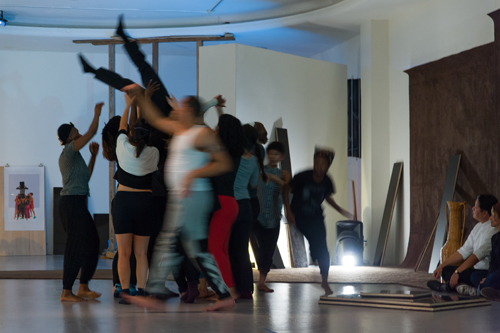
WXPT’s Meadow, photo: Christopher Wormald
Yeah, it makes me begin to wonder afresh, something like, “what is art?” You could say that in some way art becomes the filter. What is art doing, or who made art? Did I make art? Or are we making art? And then, did the definition of art change? Does art reside in the body? Where is art? And, then there’s the body stuff. How is your body? What’s going on there? Maybe by being more aware in some way that I’m not aware of yet how other people are experiencing their bodies I’ll better understand who I am. There’s something about personal identity that it’s constantly morphing. I like that. I like that we have created an opportunity to work and grow in ways and to create questions. We have to enter those questions with our bodies in order to maybe find an answer but maybe just to get to the other side of the room. Or something like that. To have a sense of the space, in a way, that we can understand bodily.
How does your body experience your pressure? Or whatever it is that we’re talking about. How is then the body dealing with it as an entity?
My questions are similar. When I said before something about the inherent value or virtue in this endeavor or this experience, and we’re all, even though our experiences are really different, in pretty strong consensus of the transformative elements of the whole thing—interpersonally, politically, physically, dynamic and transforming. That radically challenges the idea of making a product, an art-product. That seems really clear to me and then for some reason, just because it was brief, the experience of actually performing, I feel like I still have questions about what happened. Not just what people thought, because I actually didn’t get a ton of feedback, I got people’s impressions that for the most part were very visceral and emotional. Not too lengthy. For some reason there’s a sticking point for me where I wonder about…either conceptually or…What’s the word? What was made, what was crafted, what was presented? Because I feel very strong about that transmission from us to the audience. Being in the space and having the space, I saw how that changed a little bit as time went on. I wonder how that changed from night to night as time went on. If we had a longer performance practice what would come up from that? I don’t really know yet what my specific questions are regarding authorship but I know that I have the desire to talk more about that. There’s a lot of like quasi-utopian language around the formation of the group. I get really excited about those possibilities and then you know, the real-life practicalities of everything, it’s like it can’t ever be perfect. But I wonder about that transparency between all the levels of the people involved and thinking about the dancers in the company as workers. There always is a level of slight…it’s not even exploitation but the performers are always at the bottom of whatever this thing is. By participating in any way in this structure of art-making or art-world, I feel like there is always that thing there. It can’t be divorced from that. What are the ways we can continue to challenge those things, those roles, or just talk about it more? It’s not a thing that I feel very comfortable talking about either.
Talking about what?
The politics of this is our job. We’re all getting paid for this, paid for our efforts, and it’s a labor of love, and it’s what we’re doing. But it also has all of these different aspects to it. Yeah, I’m interested in different ways of addressing…
I was also really aware of a shift in the paradigm between dancing in an outdoor space and being dancers in an art space. Wherever this continues to happen, it’s a whole other set of questions to think about. Yeah, I have too many questions, I think.
I have to go, this is the shitty part of this, that I have to stop. You can continue this conversation, but this is my cue that I have to leave. Thank you so much.
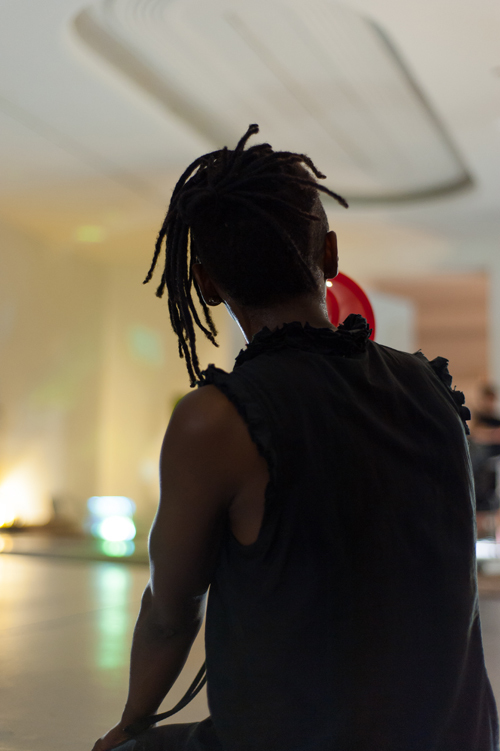
WXPT’s Meadow, photo: Christopher Wormald
LACE presents The School for the Movement of the Technicolor People, a large-scale installation and performance platform by Los Angeles based artist taisha paggett. This project, which takes the form of a dance school, is shaped by the question, “what is a Black dance curriculum today?” The installation itself, developed in collaboration with artists Ashley Hunt and Kim Zumpfe, serves as a temporary dance school, performance space and home for dance company, WXPT (We are the Paper, We are the Trees).
The core of The School for the Movement of the Technicolor People is WXPT itself — a temporary, experimental community of queer people of color and allies, dancers and non-dancers alike. WXPT was conceived by paggett in early 2015 to expand upon the language and methods of modern and contemporary dance practices, to shift the ways dancers of color are positioned within the contemporary field, and to explore questions of queer desire, responsibility, migration and historical materials that inhabit our cultural imagination. The company consists of Joy Angela Anderson, Heyward Bracey, Rebecca Bruno, Alfonso Cervera, Erin Christovale, Loren Fenton, Maria Garcia, Kloii “Hummingbird” Hollis, Jas Michelle, Meena Murugesan, taisha paggett, Sebastian Peters-Lazaro, Kristianne Salcines, Ché Ture, Devika Wickremesinghe and Suné Woods.
In May of 2015, paggett organized evereachmore, WXPT’s premiere performance created for the Bowtie Project, a partnership between Clockshop and California State Parks to activate an 18-acre post-industrial lot along the LA River. Amidst the recent unfolding of state violence against Black bodies, evereachmore sought to forge new economies of resistance, and new sensations of time, space and togetherness.
Inspired in part by a “school for colored youth” that members of paggett’s family founded in early 20th century East Texas, The School for the Movement of the Technicolor People extends the praxis of WXPT into a curriculum and pedagogy. The installation at LACE takes up the form of a school as an artistic and social problem, building the school’s curriculum and infrastructure through physical and social sculpture, performance and image, where the roles of artist and viewer, dancing and non-dancing body, art and learning coalesce.
The School for the Movement of the Technicolor People will offer a program of workshops, weekly classes and micro-performances initiated by members of WXPT. The curriculum will be open to anyone, blurring lines between audience and participant, while especially encouraging queer people of color to join. Across the bodies of the company and the members of the public who join the school, the curriculum will build an accumulative performance score in weekly increments, culminating in the performance of a “collective movement choir” at the conclusion of the exhibition.

